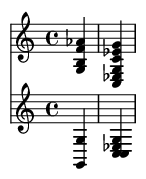Summary:
The minor ninth interval is a compound interval spanning thirteen semitones, equivalent to an octave plus a minor second. This interval creates a distinctive sound that is both dissonant and expressive, playing a crucial role in the rich tapestry of jazz harmony, impressionistic music, and contemporary composition.
Keywords:
minor ninth, compound interval, extended harmony, jazz theory, interval analysis, chromatic harmony, chord extensions, V7b9 chord, dissonance, music theory
Introduction: What is a Minor Ninth?
As we move beyond the basic intervals contained within a single octave, we enter the world of compound intervals. The minor ninth is often our first and most striking encounter in this new territory. Spanning thirteen semitones, it carries the intense, clashing quality of its simple counterpart—the minor second—but spaces it out over an octave. This separation transforms the raw dissonance into something more complex: a sound of yearning, tension, and sophisticated color that has become indispensable to modern composers and improvisers.
Definition and Construction
A minor ninth is a compound interval. To build it, you simply take a minor second and expand it by an octave. The formula is straightforward: an octave (12 semitones) plus a minor second (1 semitone) equals a minor ninth (13 semitones). Due to the inherent dissonance of the minor second relationship, the minor ninth is classified as a dissonant interval that, in traditional contexts, seeks resolution.
Interval Properties:
- Total Span: 13 semitones
- Simple Equivalent: Minor second (1 semitone)
- Formula: 1 Octave + 1 Minor Second
- Quality: Dissonant, expressive, and colorful
- Typical Resolution: The upper note typically resolves downward by step.
Visualizing the Minor Ninth
Minor Ninth from C:
An ascending minor ninth from C is D-flat in the next octave. Notice how it's simply a C to D-flat minor second, but with the D-flat raised by an octave.
Harmonic Context: The Dominant 7(b9) Chord
The most common and vital harmonic function of the minor ninth is as an extension on a dominant seventh chord. This creates the "dominant seventh flat nine" chord, written as V7(b9). The "flat nine" (b9) is the minor ninth interval above the root. This chord possesses immense tension and a powerful drive to resolve, making it a cornerstone of functional harmony, especially in jazz and classical music from the Romantic period onward.
Resolution of G7(b9) to C Minor:
In this example, a G7(b9) chord resolves to a C minor chord. Listen to how the A-flat (the b9 of G) creates tension and then resolves smoothly down to G (the fifth of the C minor chord). This downward pull is what gives the chord its powerful sense of direction.

Practical Applications in Jazz and Beyond
The minor ninth is not limited to the V7(b9) chord. It's a versatile tool for adding harmonic richness and modern color. Jazz pianists and guitarists use it constantly in chord voicings, often creating "rootless" voicings where the minor ninth's relationship to the implied root is a key source of the chord's character.
Common Applications:
- Jazz Comping: Creating tension in V7(b9) chords and color in minor or major chords.
- Classical Harmony: Used by Romantic and 20th-century composers like Chopin, Wagner, and Debussy for expressive dissonance.
- Film Scoring: Excellent for creating suspense, mystery, or poignant emotional cues.
- Contemporary Pop/R&B: Adds a touch of "jazziness" and sophistication to progressions.
Melodic Usage
Melodically, a leap of a minor ninth is dramatic and angular. It can create a sense of surprise or emotional intensity. While less common than smaller melodic leaps, it is a powerful device in the hands of a skilled composer or improviser, instantly grabbing the listener's attention.
Expressive Melodic Leap:
This short phrase demonstrates how a melodic minor ninth can be used to create an expressive peak before resolving downwards.
Historical and Modern Innovators
Many great musicians have defined their sound with this interval. Impressionist composers like Claude Debussy and Maurice Ravel used its colorful dissonance to paint hazy, atmospheric harmonies. In jazz, pianist Bill Evans was a master of incorporating the minor ninth into his lyrical and introspective voicings. Thelonious Monk used it in a more percussive, jarring way. Modern artists across genres, from jazz guitarist Pat Metheny to neo-soul innovators, continue to explore its expressive potential.
Interval Recognition: Training Your Ear
Ear Training Tips:
- Relate it to the Minor Second: Hum a minor second (like the "Jaws" theme) . Now, imagine the top note is an octave higher. That's the feeling.
- Sound Quality: It sounds "tense," "yearning," or like a "sophisticated clash." It's less grating than a minor second but still unstable.
- Resolution Tendency: Listen for its strong pull to resolve downwards. Sing the interval and then sing its resolution to train your ear on its function.
- Song Reference: The opening melody of the jazz standard "I Love You" by Cole Porter features a prominent minor ninth. The melody leaps from the root to the b9 over the song's first dominant chord.
Fun Facts
The minor ninth is sometimes nicknamed the "cryin' nine" because of its poignant, emotional quality. While the minor second is often considered the most dissonant simple interval, displacing one note by an octave to create a minor ninth transforms it from purely harsh to beautifully expressive. This magical effect of spacing is a fundamental concept in orchestration and chord voicing.
Contemporary Voicings
In modern harmony, the minor ninth is often intentionally placed against major or minor chords to create dense, emotional clusters. A common technique is to add a b9 to a major 7 chord, creating a beautifully tense Cmaj7(b9) sound, popular in modern jazz and film music.

Conclusion
The minor ninth interval is far more than just a dissonant extension; it's a gateway to a richer harmonic vocabulary. Its unique blend of tension and beauty makes it a powerful tool for expression. By understanding its construction, its primary function in the V7(b9) chord, and its creative use in melody and modern voicings, you can unlock new levels of sophistication in your own playing, composing, and listening.
References:
Levine, Mark. (1995). The Jazz Theory Book. Sher Music Co.
Persichetti, Vincent. (1961). Twentieth-Century Harmony. W. W. Norton & Company.
Evans, Bill. (1961). Sunday at the Village Vanguard. [Recording]. Riverside Records.
Debussy, Claude. (1890-1905). Préludes, Books I & II. [Sheet Music]. Durand.
